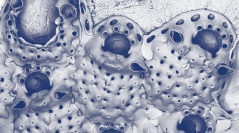The genus Collarina Jullien, 1886 (Cribrilinidae Hincks, 1879) has until now been known from the Atlantic-Mediterranean region as just two species, C. balzaci (Audouin, 1826), synonym of Collarina cribrosa Jullien, 1886, type species of the genus, considered to be widely distributed from the northern British Isles to the SE Mediterranean, and C. fayalensis Harmelin, 1978 from the Macaronesian Isles. Abundant material collected in the Mediterranean and the NE Atlantic, coupled with examination of museum specimens, allowed better definition of the species-specific morphological features in this genus and some generic traits (ooecium formation, avicularia with nested cystids). Besides the redescription of C. balzaci and C. fayalensis, this study led to the description of four new species: C. denticulata Harmelin, n. sp., recorded only in the Mediterranean, C. gautieri Harmelin, n. sp., present in both the NE Atlantic and the Mediterranean, C. macaronensis Harmelin, n. sp., from Madeira, Azores and Galicia, and C. speluncola Harmelin, n. sp., from the Mediterranean and the Gulf of Cadiz. A seventh morphotype (Collarina sp., from the Mediterranean, seemingly close to C. speluncola Harmelin, n. sp., has been left unnamed pending the availability of more abundant material. It was proven that C. balzaci: 1) has often been confused with C. gautieri Harmelin, n. sp.; 2) is exclusively epiphytic (mainly on Posidonia oceanica (L.) Delile, 1813 and brown seaweeds), with life-cycle adapted to ephemeral hosts; 3) is widely distributed in the Mediterranean, but also present in the Canaries on seaweeds, and has probably been overlooked in similar habitats in other warm-temperate NE Atlantic localities; and 4) is able to proliferate dramatically on Posidonia leaves in association with diatoms under unusual environmental conditions (Gulf of Gabes, chemical disturbance). All Collarina species live in coastal areas, mostly at shallow depth, in shaded microhabitats: plants (C. balzaci), dark cave walls (C. speluncola Harmelin, n. sp.) and small hard substrates, e.g. shells, pebbles, and anthropogenic debris (all other species).


 Zoosystema
41 (21) - Pages 385-418
Zoosystema
41 (21) - Pages 385-418